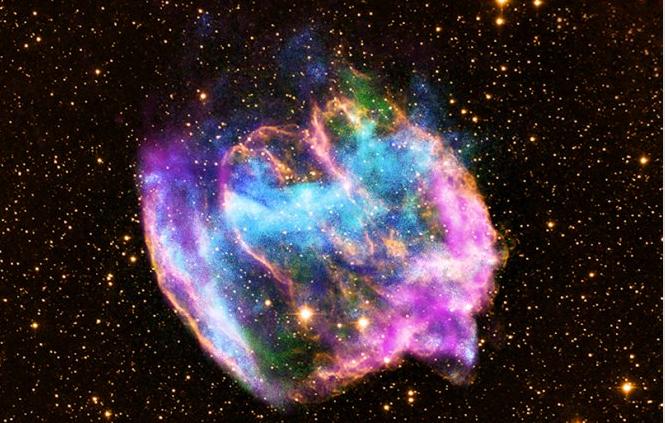NASA’s Chandra X-ray observatory may have found galaxy’s youngest black hole

Observations of a rare supernova remnant by Chandra X-ray observatory indicates the presence of our galaxy’s youngest black hole 26,000 light-years away from Earth. Scientists studied highly distorted remnant of what they believe was a rare supernova explosion wherein matter was ejected at high speeds along the poles of a rotating star. Dubbed W49B, this remnant is about a thousand years old as seen from Earth. Laura Lopez, who led the study at the Massachusetts Institute of Technology said,
“W49B is the first of its kind to be discovered in the galaxy. It appears its parent star ended its life in a way that most others don’t.”

This one was a rare supernova because usually supernova explosions happen when star’s core collapses because star is unable to sustain nuclear fusion, are symmetrical and blast stellar mass away in all directions – and have spherical shape. Whereas in the W49B supernova, material near the poles of the doomed rotating star was ejected at a much higher speed than material emanating from its equator. Jets shooting away from the star’s poles mainly shaped the supernova explosion and its aftermath.
The remnant now glows brightly in X-rays and other wavelengths, offering the evidence for a peculiar explosion. By tracing the distribution and amounts of different elements in the stellar debris field, researchers were able to compare the Chandra data to theoretical models of how a star explodes. For example, they found iron in only half of the remnant while other elements such as sulfur and silicon were spread throughout. This matches predictions for an asymmetric explosion. Co-author Enrico Ramirez-Ruiz of the University of California at Santa Cruz said,
“In addition to its unusual signature of elements, W49B also is much more elongated and elliptical than most other remnants. This is seen in X-rays and several other wavelengths and points to an unusual demise for this star.”


Most of the time, massive stars that collapse into supernovas leave a dense, spinning core called a neutron star. Astronomers often can detect neutron stars through their X-ray or radio pulses, although sometimes an X-ray source is seen without pulsations. Whereas, Chandra data revealed no evidence for a neutron star. The lack of such evidence implies a black hole may have formed. Co-author Daniel Castro (MIT) said,
“It’s a bit circumstantial, but we have intriguing evidence the W49B supernova also created a black hole. If that is the case, we have a rare opportunity to study a supernova responsible for creating a young black hole.”
Supernova explosions driven by jets like the one in W49B have been linked to gamma-ray bursts (GRBs) in other objects. GRBs, which have been seen only in distant galaxies, also are thought to mark the birth of a black hole. There is no evidence the W49B supernova produced a GRB, but it may have properties — including being jet-driven and possibly forming a black hole — that overlap with those of a GRB.
In order to improve understanding of supernovas, astronomers want to study extreme cases like the one that produced W49B. The relative proximity of W49B also makes it extremely useful for detailed study. The new results on W49B, which were based on about two-and-a-half days of Chandra observing time, appear in a paper in Sunday’s issue of the Astrophysical Journal. Study was co-authored by Sarah Pearson from the University of Copenhagen in Denmark.
Sources: NASA,Chandra X-ray observatory
Featured image: X-ray: NASA/CXC/MIT/L.Lopez et al; Infrared: Palomar; Radio: NSF/NRAO/VLA
The highly distorted supernova remnant shown in this image may contain the most recent black hole formed in the Milky Way galaxy. The image combines X-rays from NASA’s Chandra X-ray Observatory in blue and green, radio data from the NSF’s Very Large Array in pink, and infrared data from Caltech’s Palomar Observatory in yellow.

Commenting rules and guidelines
We value the thoughts and opinions of our readers and welcome healthy discussions on our website. In order to maintain a respectful and positive community, we ask that all commenters follow these rules:
We reserve the right to remove any comments that violate these rules. By commenting on our website, you agree to abide by these guidelines. Thank you for helping to create a positive and welcoming environment for all.